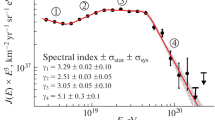Abstract
The study of the variation of fundamental constants through time or in localized regions of space is one of the goals of the Cosmic Ray Extremely Distributed Observatory which consists of multiple detectors over the Earth. In this paper, the various effects which can be potentially identified through cosmic rays detections by CREDO are presented.

Similar content being viewed by others
REFERENCES
B. Ratra and P. J. E. Peebles, “Cosmological consequences of a rolling homogeneous scalar field,” Phys. Rev. D 37, 3406 (1988).
J. P. Uzan, “Varying constants, gravitation and cosmology,” Living Rev. Rel. 14, 2 (2011).
M. Gasperini, F. Piazza, and G. Veneziano, “Quintessence as a runaway dilaton,” Phys. Rev. D 65, 023508 (2002).
N. Dhital et al., “Cosmic ray ensembles as signatures of ultra-high energy photons interacting with the solar magnetic field”; J. Cosmol. Astropart. Phys. 03, 038 (2022); arXiv:1811.10334.
D. Alvarez-Castillo et al., in Proceedings of 37th International Cosmic Ray Conference (ICRC 2021), Berlin, 2021, PoS (ICRC2021) 457 (2021).
P. Homola et al. (CREDO Collab.) “Cosmic ray extremely distributed observatory,” Symmetry 12, 1835 (2020).
Z. Stuchlík, M. Kološ, and A. Tursunov, “Penrose process: Its variants and astrophysical applications,” Universe 7, 416 (2021).
D. E. Alvarez-Castillo, “The energy budget of the transition of a neutron star into the third family branch,” Astron. Nachr. 342, 234–239 (2021).
D. Blaschke, A. Ayriyan, D. E. Alvarez-Castillo, and H. Grigorian, “Was GW170817 a canonical neutron star merger? Bayesian analysis with a third family of compact stars,” Universe 6, 81 (2020).
D. E. Alvarez-Castillo, J. Antoniadis, A. Ayriyan, D. Blaschke, V. Danchev, H. Grigorian, N. K. Largani, and F. Weber, “Accretion-induced collapse to third family compact stars as trigger for eccentric orbits of millisecond pulsars in binaries,” Astron. Nachr. 340, 878–884 (2019).
V. V. Usov, “Photon splitting in the superstrong magnetic fields of pulsars,” Astrophys. J. Lett. 572, L87 (2002).
M. Garny, M. Sandora, and M. S. Sloth, “Planckian interacting massive particles as dark matter,” Phys. Rev. Lett. 116, 101302 (2016).
Y. S. Wu and Z. Wang, “The time variation of Newton’s gravitational constant in superstring theories,” Phys. Rev. Lett. 57, 1978 (1986).
P. A. M. Dirac, “A new basis for cosmology,” Proc. R. Soc. Lond. A 165, 199-208 (1938).
G. S. Bisnovatyi-Kogan, “Checking the variability of the gravitational constant with binary pulsars,” Int. J. Mod. Phys. D 15, 1047–1052 (2006).
K. Greisen, “End to the cosmic ray spectrum?” Phys. Rev. Lett. 16, 748–750 (1966).
G. T. Zatsepin and V. A. Kuzmin, “Upper limit of the spectrum of cosmic rays,” JETP Lett. 4, 78–80 (1966).
J. Solà, “Fundamental constants in physics and their time variation: Preface,” Mod. Phys. Lett. A 30, 1502004 (2015).
T. Jacobson, S. Liberati, and D. Mattingly, “Lorentz violation at high energy: Concepts, phenomena and astrophysical constraints,” Ann. Phys. 321, 150–196 (2006).
L. Burderi et al. (GrailQuest Collab.), “GrailQuest: Hunting for atoms of space and time hidden in the wrinkle of space-time”; arXiv:1911.02154 [astro-ph.IM].
S. Weinberg, “The cosmological constant problem,” Rev. Mod. Phys. 61, 1–23 (1989).
J. Martin, “Everything you always wanted to know about the cosmological constant problem (but were afraid to ask),” C. R. Phys. 13, 566-665 (2012); arXiv: 1205.3365 [astroph.CO].
S. Appleby and E. V. Linder, “The well-tempered cosmological constant,” J. Cosmol. Astropart. Phys. 7, 34 (2018).
J. K. Webb, V. V. Flambaum, C. W. Churchill, M. J. Drinkwater, and J. D. Barrow, “Search for time variation of the fine structure constant,” Phys. Rev. Lett. 82, 884–887 (1999).
H. Chand, R. Srianand, P. Petitjean, and B. Aracil, “Probing the cosmological variation of the fine-structure constant: Results based on VLT-UVES sample,” Astron. Astrophys. 417, 853 (2004).
J. Mould and S. Uddin, “Constraining a possible variation of G with type Ia supernovae,” Publ. Astron. Soc. Austral 31, 15 (2014).
J. D. Anderson, G. Schubert, V. Trimble, and M. R. Feldman, “Measurements of Newton’s gravitational constant and the length of day,” Europhys. Lett. 110, 10002 (2015).
R. E. Eaves, “Constraints on variation in the speed of light based on gravitational constant constraints,” Mon. Not. R. Astron. Soc. 505, 3590–3595 (2021).
L. Bibrzycki et al. (CREDO Collab.), “Machine learning aided noise filtration and signal classification for CREDO experiment,” arXiv:2110.00297 [physics.ins-det].
ACKNOWLEDGMENTS
D. A-C. thanks the organizers of the of International Conference on Precision Physics and Fundamental Physical Constants 2021 for their hospitality and attention during the on-site conference in Slovakia. The author acknowledges support from the Bogoliubov Laboratory of Theoretical Physics in order to attend this conference as well as from the Bogoliubov-Infeld program for collaboration between JINR and Polish Institutions and from the COST actions CA16214 (PHAROS) for networking.
Author information
Authors and Affiliations
Corresponding author
Ethics declarations
The author declares that he has no conflicts of interest.
Rights and permissions
About this article
Cite this article
Alvarez Castillo, D. Studying the Variation of Fundamental Constants at the Cosmic Ray Extremely Distributed Observatory. Phys. Part. Nuclei 53, 825–828 (2022). https://doi.org/10.1134/S1063779622040025
Received:
Revised:
Accepted:
Published:
Issue Date:
DOI: https://doi.org/10.1134/S1063779622040025



